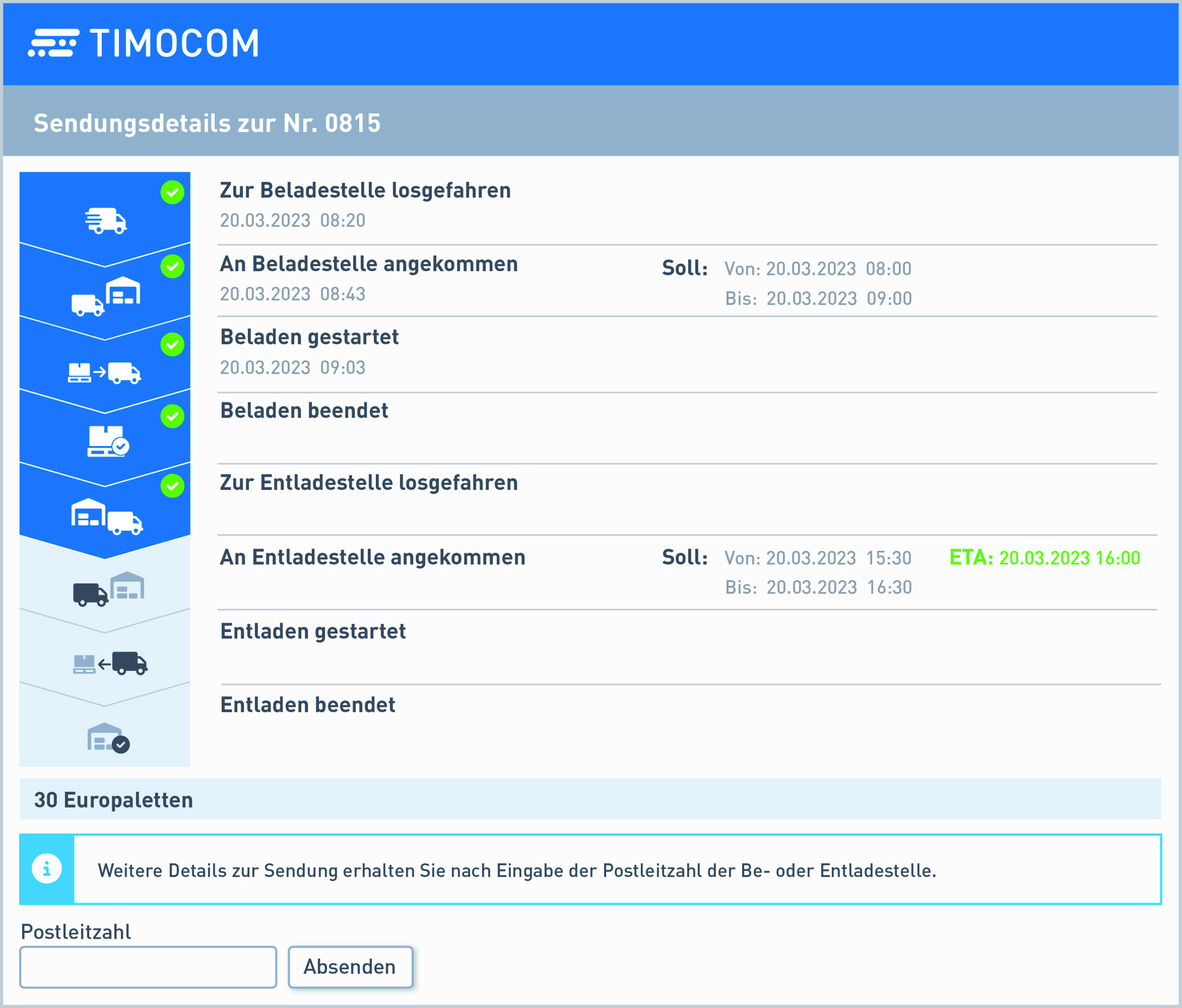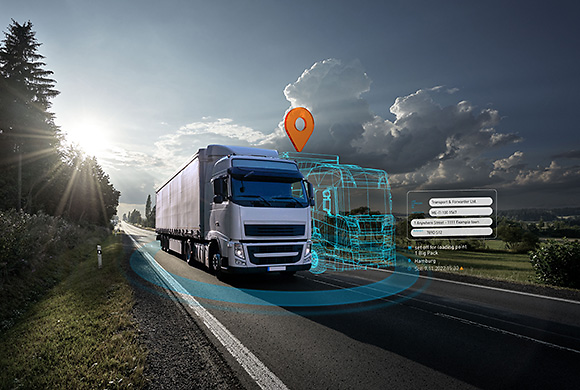Truck tracking technologies – an overview
From GPS trackers for trucks to live shipment tracking

Being able to know where transport assignments are 24/7 is an opportunity that freight forwarders, manufacturers and trade companies can’t afford to miss. Say hello to live tracking – state-of-the-art GPS technology that allows you to follow the exact location of your vehicles or individual shipments, thus giving you an immediate strategic advantage. But how does this technology work – and how can it give your company a competitive edge? In this blog post, we’ll take a look at the various technologies involved and go through the advantages of each of them, as well as delve into the all-important issues of data protection and integration.
No traffic jams, no delivery bottlenecks and no shortage of hauliers. We offer balanced loading capacities and a transparent logistics process that gets goods to their destination safely and without delays. As things stand today, the idea of ‘a world without logistical challenges’ seems a long way off. But for TIMOCOM, this is a vision that we are working on every day.
Are you planning to visit IAA 2024 in Germany? Visit us in Hall 13 at Stand C30 to discuss our digital solutions to logistical problems in road freight transport. Arrange your appointment now and speak to our experts!
What is truck tracking?
The term ‘tracking’ simply means to follow the movements of somebody or something. So by extension, truck tracking (also known as lorry tracking or HGV tracking) is the process of tracking the exact location of heavy goods vehicles in real time. Companies can use state-of-the-art GPS tracking systems and integrate the data they provide into the relevant areas of their logistic software to monitor the live location, speed and route of their vehicles.
Why truck tracking is vital for the logistics industry
Truck tracking has caused a fundamental shift in the logistic industry. Until a few years ago, companies had almost no idea where their vehicles and shipments were after they left the ramp or what their status was. Each day was a constant barrage of uncertainty and inefficiency. Dispatchers and logistics managers were heavily reliant on manual communication and flat out guesswork. Today, real-time tracking increases transparency and efficiency, improving the entire supply chain as a result.
Companies can plan or adapt connected processes with greater speed and precision, improve customer communication and ensure the reliability of their freight. Drivers are better equipped to follow their driving and rest period schedule, reducing the overall pressure on them.
What are telematics systems?
Truck tracking is based on telematics systems. They combine telecommunications and IT to collect and transmit all the data pertaining to vehicles. These systems often not only record GPS data, but also information about the status of the vehicle, driving performance and environmental conditions. They enable companies to analyse their logistics processes in detail and optimise them. Data protection is a key part of using truck tracking and telematics systems. Companies need to ensure that the data they collect is stored securely and is only used for the purposes for which they are authorised. This includes making sure that they comply with EU General Data Protection Regulation (GDPR) and any other relevant legislation. Secure encryption and access controls are essential to ensuring data integrity and preventing it from being misused. This means that companies need to invest in secure IT infrastructures to ensure the data they collect is protected, or rely on solutions such as TIMOCOM that comply your and your business partners’ data protection guidelines.
Truck tracking is the foundation of live shipment tracking
What is live shipment tracking in logistics?
Live shipment tracking is an advanced technology used in the logistics and transport industry to monitor and track the status and location of shipments in real time. It makes the entire transport process transparent from start to finish and enables everyone involved to access exact information on the current status of the delivery around the clock.
The difference between truck tracking and live shipment tracking
Truck tracking and live shipment tracking are closely linked to one another, but they focus on different things and serve different purposes. Live shipment tracking is based on truck tracking, but goes one step further in that it monitors both the location and status of the shipment in real time. There are eight different statuses that can be shared. Geofences are used to automatically provide the following notifications based on the vehicle’s location: ‘Arrived at loading point’, ‘Departed for unloading point’, ‘Arrived at unloading point’ and ‘Unloading completed’. This combination of real-time information and automated status notifications significantly improve both time slot management and communication between dispatchers, drivers and transport customers, thus optimising planning and increasing customer satisfaction as a result. While truck tracking forms the basis for location monitoring, live shipment tracking adds to this data with a deeper, proactive insight into the entire transport process.

* please note the above image shows the shipment details in German
Here’s a recap of the key areas where live shipment tracking goes beyond the concept of basic tracking:
- Real-time updates: Live shipment tracking provides constant updates on the status of a shipment in real time, including information such as the loading and unloading status, traffic conditions and expected time of arrival (ETA).
- Automated status notifications: Rather than having to manually ask about a shipment’s progress, everyone involved instead receives automatic notifications, including key milestones such as departure and arrival times, as well any delays encountered.
- Integrated communication: Live shipment tracking massively simplifies communication between dispatchers, drivers and transport customers. Status updates and changes to ETAs are sent immediately, thus avoiding misunderstandings and eliminating unnecessary phone calls.
- Time slot management: Exact ETA calculations allow recipients to plan their processes better, helping to reduce waiting times to minimum and maximise efficiency at the unloading point.
Learn more about Live Shipment Tracking at TIMOCOM. Register your business today.
Technical requirements for live shipment tracking
There are certain technical requirements that need to be met if a company wants to implement live shipment tracking and telematics systems:
- GPS devices: These devices record the vehicle’s exact location data.
- Telematics hardware: Comprehensive telematics systems include sensors and communication modules that collect and transmit data.
- Software integration (not a must for live shipment tracking, as this can be used without a TMS): The data that is collected must be integrated in the company’s existing transport management (TMS) or enterprise resource planning (ERP) systems to enable seamless processing and analysis. We have developed APIs specifically for the purpose of integrating this data into your system, reducing your IT costs and making duplicate entries a thing of the past.
Benefits of truck tracking and live shipment tracking and applying the two in tandem
- Real-time transparency: Live shipment tracking provides full transparency of your transport assignments. You can see the live location of your vehicles at any time, enabling you to plan your routes and schedules more efficiently. This also affects downstream processes in particular, such as ramp management and the associated waiting times.
- Cost efficiency thanks to route optimisation: Truck tracking and live shipment tracking allows companies to plan the most efficient routes for their vehicles based on real-time traffic information and historical data. This reduces driving times, consumes less fuel and lowers operating costs.
- Saves time: Real-time monitoring allows dispatchers to react to problems such as traffic jams, road closures and accidents immediately and suggest alternative routes. This reduces the number of delays and improves on-time delivery. It also eliminates the need to inform customers or business partners by phone or e-mail.
- Automatic status updates: Having status updates on your shipments sent out automatically means that you and any partners who need this information are always up to date. This feature brings the amount of administrative effort down to a minimum and allows you to focus on what’s important.
- Information is shared with business partners: Our Live Tracking and Live Shipment Tracking APIs enable you to easily share all the transport information with your business partners that they need. This fosters collaborations and improves everyone’s satisfaction. Plus, you always have the power to decide which data you share with whom, meaning you can protect any sensitive data you may have while still giving everyone involved in the supply chain access to what they need.
- Monitoring and driving performance: GPS devices also enable companies to monitor driving performance, meaning they can ensure their drivers are safe and efficient while they’re on the road. This reduces the number of accidents and improves protection for the drivers and their freight.
- Greater safety, security and reliability: Live shipment tracking offers you greater safety, security and reliability, as you can track the exact location of a vehicle around the clock, meaning you can quickly locate it in the event of an accident or even theft.
Why live shipment tracking is becoming indispensable
Live shipment tracking is more than just a nice feature – it's a vital component of modern logistics solutions. By providing real-time information and automatic updates, it helps make companies more efficient, reduces costs and improves customer satisfaction. No matter if you’re a freight forwarder, manufacturer or trade company – live shipment tracking is key to optimising your logistics processes and achieving success.
Our services and APIs compatible with your TMS or ERP systems not only help you create transparency and trust, but also lay the foundation for future-oriented logistics management.
